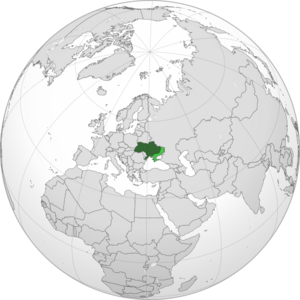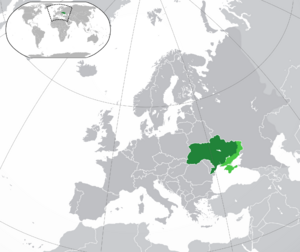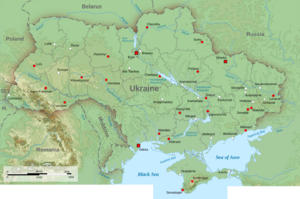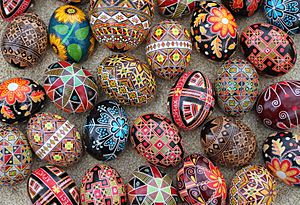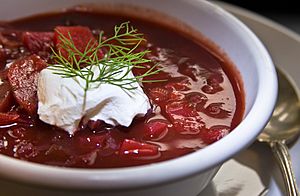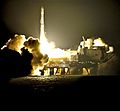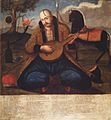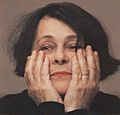Ukraine facts for kids
Quick facts for kids
Ukraine
Україна (Ukrainian)
|
|
|---|---|
|
Territory controlled by Ukraine Russian-occupied territories
|
|
| Capital and largest city
|
Kyiv 50°27′N 30°31′E / 50.450°N 30.517°E |
|
Ukrainian |
| Ethnic groups
(2001)
|
|
| Religion
(2018)
|
|
| Demonym(s) | Ukrainian |
| Government | Unitary semi-presidential republic |
| Volodymyr Zelenskyy | |
| Yulia Svyrydenko | |
|
• Chairman of the
Verkhovna Rada |
Ruslan Stefanchuk |
| Legislature | Verkhovna Rada |
| Formation | |
| 882 | |
| 1199 | |
| 18 August 1649 | |
| 20 November 1917 | |
| 10 March 1919 | |
|
• UN membership
|
24 October 1945 |
|
• Independence declared
|
24 August 1991 |
|
• Current constitution
|
28 June 1996 |
| Area | |
|
• Total
|
603,628 km2 (233,062 sq mi) (45th) |
|
• Water (%)
|
3.8 |
| Population | |
|
• April 2025 estimate
|
|
|
• Density
|
54.4/km2 (140.9/sq mi) (156th) |
| GDP (PPP) | 2025 estimate |
|
• Total
|
|
|
• Per capita
|
|
| GDP (nominal) | 2025 estimate |
|
• Total
|
|
|
• Per capita
|
|
| Gini (2020) | ▼ 25.6 low |
| HDI (2023) | high · 87th |
| Currency | Hryvnia (₴) (UAH) |
| Time zone | UTC+2 (EET) |
|
• Summer (DST)
|
UTC+3 (EEST) |
| Date format | dd.mm.yyyy |
| Driving side | right |
| Calling code | +380 |
| ISO 3166 code | UA |
| Internet TLD |
|
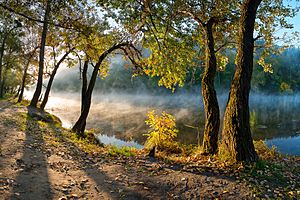
Ukraine (Ukrainian: Україна, romanized: Ukraïna) is a large country in Eastern Europe. It shares borders with Russia to the north-east, Belarus to the north-west, and Poland and Slovakia to the west. To the south-west, it borders Hungary, Romania, Moldova, and Transnistria. The Black Sea lies to its south.
Ukraine is a republic, meaning its government is run by elected officials. The capital city of Ukraine is Kyiv (Ukrainian: Київ). Ukraine was once part of the Soviet Union from 1922 until it became independent in 1991.
Contents
What Language Do People Speak in Ukraine?
The official language of Ukraine is Ukrainian (Ukrainian: українська мова). In 2001, about 29% of people in Ukraine said that Russian was their main language. Both Ukrainian and Russian are Slavic languages, which means they are related but also have differences.
How is Ukraine Divided?
Ukraine is a unitary state. This means it has one central government and similar rules for all its parts.
Ukraine has twenty-four oblasts (provinces). The 24 oblasts are divided into 136 districts (raions) and city municipalities.
Places where people live in Ukraine are either urban (cities and towns) or rural (villages and settlements). Cities have different levels of self-rule. This depends on their size, importance, and history.
What are Ukraine's Biggest Cities?
The largest cities in Ukraine are:
- Kyiv: This city was the capital of Kievan Rus' from the late 9th century. It has been the capital of independent Ukraine since 1919.
- Kharkiv: This city was the capital of Ukraine from 1919 to 1934.
- Dnipro
- Odesa
- Zaporizhia
- Lviv
Where Did the Name "Ukraine" Come From?
The name "Ukraine" (u-krayina) has often been thought to mean "edge" or "borderland." However, some people now suggest it might mean "territory." Language experts are still studying the history of this word.
The name was first used in the 12th century for a central part of the Kievan Rus' area. Historically, in English, people used to say "the Ukraine." But since Ukraine became independent in 1991, it is now correct to simply say "Ukraine."
A Look at Ukraine's Past
Early History of Ukraine
Many different groups of people lived in the area of modern Ukraine long ago. Historians believe that the Great Steppe (a large grassland) north of the Black Sea was the original home of many Indo-European languages.
Around the 4th century AD, a group called the Antes formed a state. This state later fell, and by the 7th century, more than 10 tribal groups joined together as "Slavs." They created a state called Rus. Historians believe this state had three main centers: Kuyavia (around Kyiv), Slavia (around Novgorod), and Artania (whose exact location is unknown).
Kyiv became the capital of a large and powerful state in Europe by the 10th century.
The Kyivan Rus' State
Kyivan Rus' was a medieval state of Eastern Slavs. It was formed with the help of Varangians (Vikings) who helped unite different tribes. The Varangian princes who ruled Rus eventually blended in with the local people.
During the rule of Volodymyr the Great (980-1015), the Kyivan State grew significantly. It stretched from northern lakes to southern rivers, covering about 800,000 square kilometers. Volodymyr decided to make Christianity the main religion for everyone in the state. He used missionaries and, at times, force to baptize the people of Kyiv. For this, he is known as Vladimir the Baptist.
Under Yaroslav the Wise (1019–1054), Kyivan Rus' reached its peak in culture and military strength. It became very important in Europe, influencing politics and trade. Kyivan princes had strong ties with countries like France, Sweden, and Byzantium.
The Kyivan State also ruled over non-Slavic people, who gradually mixed with the Slavs. This helped form the future Eastern Slavic peoples. Kyivan Rus' acted as a shield for Europe, slowing down the movement of nomadic groups from the East.
After 1132, Kyivan Rus' began to break apart into many smaller areas called principalities. Kyiv remained an important center, but other cities also grew powerful.
Why Did Kyivan Rus' Break Apart?
Several reasons led to the breakup of Kyivan Rus':
- Rules for who would inherit land were different in various regions.
- Local areas developed their own interests, weakening the central government.
- Local nobles and princes gained more power, caring less about the whole state.
- There was no single ruling family in Kyiv, leading to struggles for control.
- Nomadic groups from the east increased their attacks on Kyivan lands.
In 1206, the powerful Mongolian state, led by Genghis Khan, began conquering lands. In 1223, Tatar-Mongols defeated the princes of Southern Rus' near the Kalka River. In 1240, they attacked and destroyed Kyiv. Most of Rus' became part of the Golden Horde, which stretched from the Ural Mountains to the Black Sea.
After Kyiv fell, the main center for Ukrainian lands moved to the Halycian-Volyn region. Prince Danylo of Halych had to accept the Golden Horde's rule in 1245. He tried to get help from Catholic Europe and even became a King in 1253. However, without military support from the West, he had to recognize the Horde's power again.
By the end of the 14th century, Ukrainian lands were divided among different states. Lithuania, Poland, the Crimean Khanate, and Muscovy (early Russia) all controlled parts of Ukraine. In 1569, Lithuania and Poland joined to form the Commonwealth, bringing central Ukrainian lands under Polish control.
What Does "Rus'" Mean?
The name "Rus'" refers to the Kyivan State. There are different ideas about where the name "Rus'" came from:
- Some historians believe it came from the Normans (Vikings) who founded the state. This is called the 'Norman theory'.
- Others think "Ruses" was a Slavic tribe living near the Dnieper River.
- Another idea is that "Rusa" is an old Slavic word for 'river'.
Ukrainian historians often believe the name came from Slavic tribes or the territory around Kyiv, Chernihiv, and Pereiaslav.
The Cossack State
In the late 15th century, groups of warriors called Cossacks appeared in the "wild steppes" of Zaporizhia, between Lithuania, Muscovy, and Crimea. Their military center was the Sich. Zaporizhian Cossacks fought in many wars for the Commonwealth (Poland-Lithuania).
Cossacks also launched their own attacks into Moldavia, Muscovy, and Crimea, often for looting. They sometimes worked as mercenaries, for example, during the Thirty Years' War.
Because of unfair treatment by nobles, Cossacks often rebelled. They fought to protect the rights of the Ukrainian people in the Commonwealth, who faced religious and national oppression.
Ukraine in the 20th Century
In 1917, an independent Ukrainian People's Republic was formed. However, the Red Army (Soviet forces) took control, and it became the Ukrainian Soviet Socialist Republic.
In the 1920s, Soviet Russia encouraged the Ukrainian language and Ukrainian culture. But in the 1930s, this changed, and there were efforts to make Ukrainians more like Russians. Many Ukrainian writers and historians faced harsh treatment. Millions of people also died from starvation in 1932 and 1933, similar to other parts of the Soviet Union.
During World War II, some Ukrainian nationalists worked with the Nazis, hoping to regain independence. They were involved in terrible acts against Jewish and Roma people. However, their hopes for independence were crushed. Ukrainian nationalists formed the Ukrainian Insurgent Army, which fought against both Nazi Germany and Soviet forces. Most Ukrainians fought alongside the Soviet Union to free Ukraine from Nazi Germany.
In 1986, a major accident happened at the Chernobyl Nuclear Power Plant. One of its reactors exploded, releasing dangerous radiation over northern Ukraine and southern Belarus. This was one of the worst nuclear accidents in history.
After the Soviet Union took control again, actions against Ukrainian nationalists continued until the Soviet Union broke up in 1991. Ukraine declared its independence on August 24, 1991.
Modern Independent Ukraine
Since gaining independence, Ukraine has held presidential and parliamentary elections. Its current constitution was adopted on June 28, 1996.
In late 2004, large protests called the Orange Revolution (Ukrainian: Помаранчева революція) took place. Millions of people protested after a presidential election, believing the results were unfair. The Constitutional Court ordered a new election, which Victor Yuschenko won.
In November 2013, big pro-European Union protests, known as Euromaidan (Ukrainian: Євромайдан), began. These protests led to the president leaving office in February 2014.
In March 2014, Russia took control of Crimea and held a vote that declared Crimea independent, then annexed it. Most countries did not accept this. Many countries used economic sanctions to punish Russia.
In April 2014, a conflict began in eastern Ukraine, in the Donbas region, which has many Russian-speaking people. This war changed Ukraine's focus towards closer ties with the West. Ukraine signed an agreement with the EU in June 2014, and its citizens later gained the ability to travel to the European Union without a visa. In 2019, the Orthodox Church of Ukraine became independent from Moscow, which was a big step for Ukraine's religious identity. In June 2022, during a full-scale war with Russia, Ukraine was given "candidate status" to join the European Union.
How Ukraine's Government Works
Ukraine is led by a president, who is elected by the people for a five-year term. The president is the formal head of state.
Ukraine's law-making body is the Verkhovna Rada, a parliament with 450 seats. The parliament is mainly responsible for forming the government, including the Cabinet of Ministers, which is led by the prime minister. The president can choose the ministers of foreign affairs and defense, who then need parliament's approval. The president also appoints the prosecutor general and the head of the Security Service.
Laws and decisions made by the parliament, cabinet, or president can be cancelled by the Constitutional Court if they go against the constitution. The Supreme Court is the highest court for general cases.
Local governments are also guaranteed. Local councils and city mayors are elected by the people and manage local budgets. The heads of regional and district administrations are chosen by the president, based on the prime minister's suggestions.
Presidents of Ukraine
- Mykhaylo Hrushevsky (1917 — 1922)
- Leonid Makarovych Kravchuk (1991—1994)
- Leonid Danylovych Kuchma (1994—2005)
- Victor Yushchenko (2005—2010)
- Victor Yanukovych (2010—2014)
- Oleksandr Turchynov (2014)
- Petro Poroshenko (2014–2019)
- Volodymyr Zelensky (since 2019)
Ukraine's Geography
Ukraine is the second-largest country in Europe after Russia. It is the largest country located entirely within Europe. Ukraine covers an area of about 603,550 square kilometers (233,013 square miles) and has a coastline of 2,782 kilometers (1,729 miles).
Most of Ukraine's landscape is made up of fertile steppes (flat grasslands with few trees) and plateaus. Rivers like the Dnieper, Seversky Donets, Dniester, and Southern Bug flow through these plains towards the Black Sea and the smaller Sea of Azov. In the southwest, the Danube Delta forms part of the border with Romania.
Ukraine's only mountains are the Carpathian Mountains in the west, where the highest peak is Hoverla at 2,061 meters (6,762 feet). The Crimean Mountains are in the far south along the coast.
Ukraine has important natural resources such as lithium, natural gas, kaolin, timber, and lots of arable land (land suitable for farming).
Climate in Ukraine
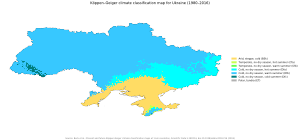
Ukraine generally has a continental climate, meaning it has warm summers and cold winters. However, its southern coasts have a cold semi-arid and humid subtropical climate. Average yearly temperatures range from 5.5 to 7°C (42 to 45°F) in the north, and 11 to 13°C (52 to 55°F) in the south.
More rain falls in the west and north of Ukraine, while the east and southeast receive less. Western Ukraine, especially the Carpathian Mountains, gets about 120 cm (47 inches) of rain each year. Crimea and the Black Sea coastal areas get around 40 cm (16 inches).
Climate change is expected to reduce water availability from major rivers, especially in summer. This could affect farming, particularly in the southern steppe regions. The World Bank says Ukraine is very vulnerable to climate change.
Wildlife and Nature in Ukraine
Ukraine has six different natural regions, including mixed forests, forest steppes, and steppes. There are more coniferous (evergreen) trees than deciduous (leaf-shedding) trees. The most forested area is Polisia in the northwest, with pine, oak, and birch trees.
Ukraine is home to 45,000 species of animals, mostly invertebrates. About 385 species are endangered and listed in the Red Data Book of Ukraine. Important wetlands cover over 7,000 square kilometers (2,700 square miles), with the Danube Delta being very important for nature conservation.
Ukraine's Languages
According to Ukraine's constitution, the state language is Ukrainian. However, Russian is also widely spoken, especially in eastern and southern Ukraine. Most people who speak Ukrainian as their first language also know Russian. Russian was the main language in the Soviet Union, but Ukrainian also had official status in the Ukrainian Soviet Socialist Republic, and learning Ukrainian was required in schools.
Religion in Ukraine
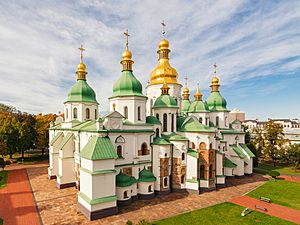
Ukraine has the second-largest Eastern Orthodox population in the world, after Russia.
In 2019, 82% of Ukrainians were Christians. Of these, 72.7% were Eastern Orthodox, 8.8% were Ukrainian Greek Catholics, 2.3% were Protestants, and 0.9% were Latin Church Catholics. Other Christians made up 2.3%. Small numbers of people followed Judaism, Islam, and Hinduism.
Ukrainian Culture

Ukrainian traditions are strongly shaped by Orthodox Christianity, which is the main religion. Family roles tend to be traditional, and grandparents often play a big part in raising children. Ukraine's culture has also been influenced by its neighbors, which you can see in its buildings, music, and art.
During the Communist era, art and writing in Ukraine were greatly affected. In 1932, a policy called socialist realism was introduced, which limited artistic freedom. However, in the 1980s, "glasnost" (openness) allowed artists and writers to express themselves more freely again.
As of 2023, UNESCO has listed 8 places in Ukraine as World Heritage Sites. Ukraine is also famous for its decorative arts and folk traditions, like Petrykivka painting, Kosiv ceramics, and Cossack songs. Sadly, between February 2022 and March 2023, UNESCO confirmed damage to 247 sites due to conflict. Since January 2023, the historic center of Odesa has been added to the List of World Heritage in Danger.
The tradition of decorating Easter eggs, called pysanky, is very old in Ukraine. Designs are drawn on the eggs with wax, then dyes are applied. The wax is removed later, revealing colorful patterns. This tradition is thousands of years old, even older than Christianity in Ukraine. In the city of Kolomyia, there is a museum of Pysanka built in 2000.
Ukrainian Food
Traditional Ukrainian food includes chicken, pork, beef, fish, and mushrooms. Ukrainians also eat a lot of potatoes, grains, and fresh, boiled, or pickled vegetables.
Some popular traditional dishes are:
- Varenyky: Boiled dumplings with fillings like mushrooms, potatoes, sauerkraut, or cherries.
- Nalysnyky: Pancakes with fillings such as quark (a type of cheese), poppy seeds, or meat.
- Kapusnyak: A cabbage soup often made with meat, potatoes, and millet.
- Borscht: A famous red soup made from beets, cabbage, and sometimes meat.
- Holubtsi: Stuffed cabbage rolls filled with rice and minced meat.
Traditional baked goods include decorated korovais and paska Easter bread. Other Ukrainian specialties are Chicken Kiev and Kyiv cake.
Ukrainians drink kompot (stewed fruit compote), juices, milk, ryazhanka, mineral water, tea, and coffee. Alcoholic drinks include beer, wine, and horilka.
Images for kids
-
Gold Scythian pectoral, a neckpiece from the 4th century BC.
-
The baptism of Grand Prince Vladimir led to Christianity in Kievan Rus'.
-
Principalities of Kievan Rus', 1054–1132.
-
After the Mongol invasion, much of Ukraine was controlled by Lithuania and later the Polish-Lithuanian Commonwealth, shown here in 1619.
-
Bohdan Khmelnytsky, a Hetman of Ukraine, who helped establish an independent Ukraine after the 1648 uprising.
-
The Cossack Hetmanate is seen as a direct ancestor of modern Ukraine.
-
The Battle of Poltava in 1709, painted by Denis Martens the Younger in 1726.
-
Nikita Khrushchev and Leonid Brezhnev, who later became leaders of the Soviet Union.
-
Sergey Korolyov, a Ukrainian-born rocket engineer who led the Soviet space program.
-
Ukrainian President Leonid Kravchuk and Russian President Boris Yeltsin signing the agreement that ended the Soviet Union in 1991.
-
A pro-EU demonstration in Kyiv during Euromaidan on November 27, 2013.
-
OSCE monitoring heavy weapons in eastern Ukraine in 2015.
-
The Antonov An-225 Mriya, the aircraft with the largest wingspan.
-
A high-speed train in Ukraine. Rail transport is widely used.
-
Crimea is known for its seaside resorts and historic sites.
-
The Saint Sophia Cathedral in Kiev, a UNESCO World Heritage Site.
-
Kira Muratova, a famous Ukrainian film director.
-
Ukrainian footballer Andriy Shevchenko celebrating a goal at Euro 2012.
-
The Kingdom of Galicia–Volhynia (1245–1349).
-
Historical map of the Grand Duchy of Lithuania, Rus' and Samogitia until 1434.
-
Ukrainian Cossack Hetmanate and Zaporozhian Cossacks under Russian Empire rule (1751).
-
Dawn on South Demerdji, Alushta, Crimea.
-
A typical agricultural landscape of Ukraine, Kherson Oblast.
-
Kinburn sandbar, Ochakiv Raion, Mykolaiv Oblast.
-
Alkhovitin, Zuivskyi regional landscape park, Donetsk Oblast.
-
The Transfiguration Cathedral in Chernihiv dates to Kievan Rus', 1030.
-
Kamianets-Podilskyi Castle – one of the Seven Wonders of Ukraine.
-
St Andrew's Church in Kiev, an example of Baroque style.
-
Lviv's Old Town; its architecture shows influences from its history as part of Austria-Hungary and Poland.
-
St. Michael's Golden-Domed Cathedral in Kiev, an example of Ukrainian Baroque.
-
An example of early 20th-century architecture in Lviv.
-
Central Department store in Kiev, an example of Stalinist architecture.
-
Modern residential architecture in Kharkiv.
See Also
 In Spanish: Ucrania para niños
In Spanish: Ucrania para niños




